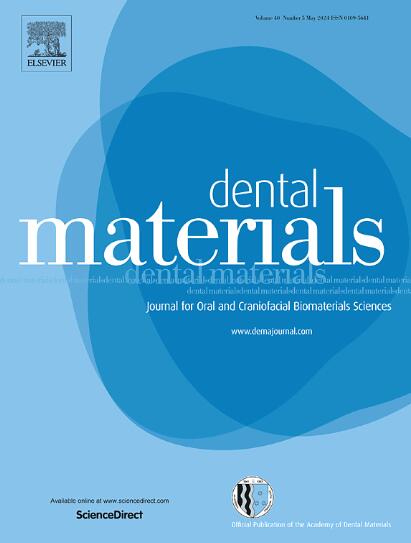Chemical analysis and performance evaluation of ClearCorrect® aligners as received and after intraoral use: Implications for durability, aesthetics, and patient safety
IF 4.6
1区 医学
Q1 DENTISTRY, ORAL SURGERY & MEDICINE
引用次数: 0
Abstract
Background
Orthodontic treatment with transparent aligners is popular with patients. Any alteration of the plastic material, as subjected to the oral environment, could influence the treatment's durability, the aligner's aesthetic appearance, and the patient's safety.
Purpose
This study concerns the physicochemical properties of ClearCorrect® aligners before and after intraoral use, focusing on transparency, surface topography, leachable, polymer glass transition temperature, and viscoelastic properties.
Methods
Aligners were collected after two weeks of intraoral use. Unused samples were obtained from the manufacturers. Transparency was measured by UV–visible spectroscopy. Chemical modifications were studied using infrared and Raman spectroscopies. Thermal degradation, glass transition (Tg), and storage modulus (E') were characterized by thermal analysis (DSC, TGA, DMA). Surface morphology and roughness were studied thanks to SEM and AFM. Aligners were immersed in water-based solutions to identify and quantify organic leachable by HPLC chromatography and trace elements by atomic absorption spectroscopy.
Results
ClearCorrect® aligners have a three-layer structure (outer PETG/inner PU layers). Slight chemical alterations occurred after aging. There was also no significant evolution in Tg and thermal degradation temperatures and only a minimal evolution of E'. Surface and transparency alterations occurred. A difference in organic compound and trace element release levels between new and used aligners was evidenced, suggesting an intraoral release during use.
Significance
Intra-oral aging mainly impacts the aligner transparency and surface. The leachable study suggests significant ingestion of organic and non-organic compounds by the patient: investigations are needed to assess the impact of the long-term use of trays on patient health.
对收到的和口内使用后的 ClearCorrect® 矫正器进行化学分析和性能评估:对耐用性、美观和患者安全的影响。
背景:使用透明矫治器进行正畸治疗深受患者欢迎。目的:本研究涉及口内使用前后透明矫治器的理化性质,重点是透明度、表面形貌、可浸出性、聚合物玻璃化转变温度和粘弹性:方法:口内使用两周后收集矫正器。未使用的样本从生产商处获得。用紫外可见光谱法测量透明度。使用红外光谱和拉曼光谱研究化学修饰。热分析(DSC、TGA、DMA)对热降解、玻璃化转变(Tg)和存储模量(E')进行了表征。利用扫描电镜和原子力显微镜对表面形态和粗糙度进行了研究。将对准器浸入水基溶液中,通过 HPLC 色谱法识别和量化有机浸出物,并通过原子吸收光谱法识别和量化痕量元素:结果:ClearCorrect®矫治器具有三层结构(外层 PETG/内层 PU)。老化后会发生轻微的化学变化。Tg 和热降解温度也没有明显变化,E'的变化很小。表面和透明度发生了变化。新旧矫正器的有机化合物和微量元素释放水平存在差异,这表明在使用过程中存在口内释放:意义:口内老化主要会影响矫正器的透明度和表面。可浸出研究表明,患者摄入了大量有机和非有机化合物:需要进行调查,以评估长期使用矫治器对患者健康的影响。
本文章由计算机程序翻译,如有差异,请以英文原文为准。
求助全文
约1分钟内获得全文
求助全文
来源期刊

Dental Materials
工程技术-材料科学:生物材料
CiteScore
9.80
自引率
10.00%
发文量
290
审稿时长
67 days
期刊介绍:
Dental Materials publishes original research, review articles, and short communications.
Academy of Dental Materials members click here to register for free access to Dental Materials online.
The principal aim of Dental Materials is to promote rapid communication of scientific information between academia, industry, and the dental practitioner. Original Manuscripts on clinical and laboratory research of basic and applied character which focus on the properties or performance of dental materials or the reaction of host tissues to materials are given priority publication. Other acceptable topics include application technology in clinical dentistry and dental laboratory technology.
Comprehensive reviews and editorial commentaries on pertinent subjects will be considered.
 求助内容:
求助内容: 应助结果提醒方式:
应助结果提醒方式:


